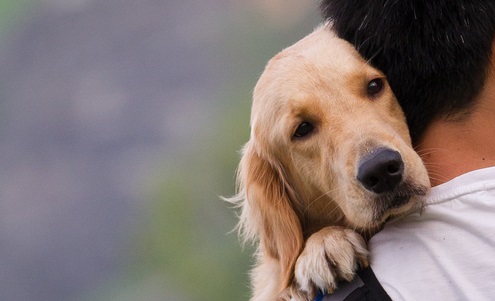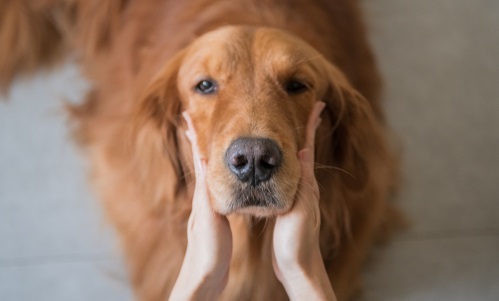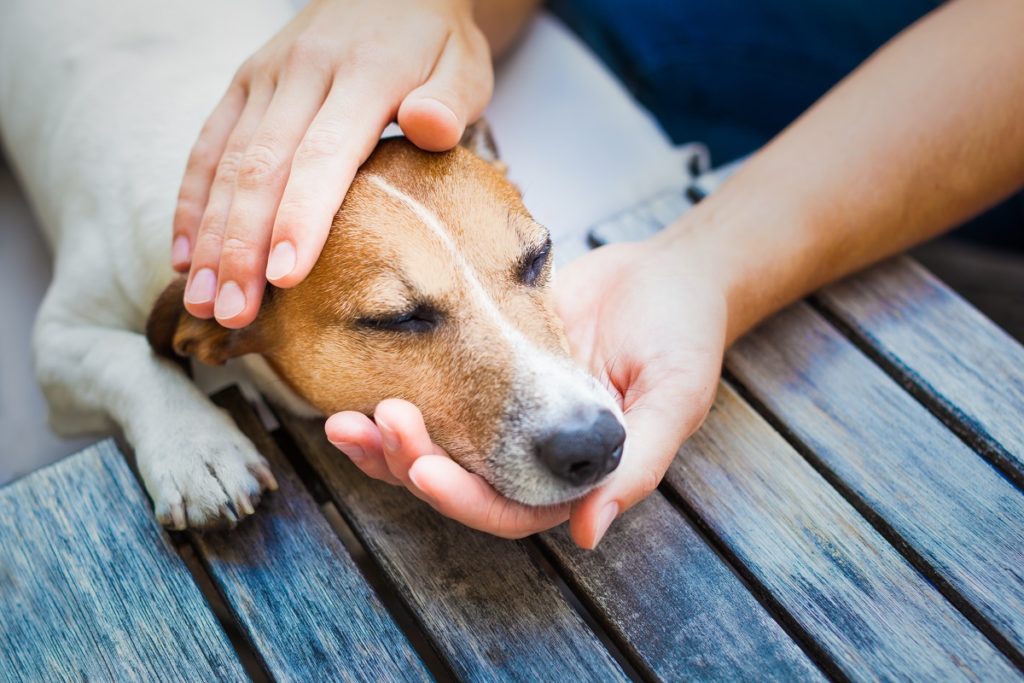When most people hear the world “concussion” they immediately think of the traumatic brain injury most football, soccer or basketball players get from being hit in the head while competing in their sport. With the rise of concern for helmet and tackling safety, some people have begun to wonder, “Can dogs get concussions like humans?” While your dog probably isn’t a professional athlete, the risk of concussion is very real. Even though dogs tend to have thicker skulls and are more pain resistant, head injuries still happen. With the lack of verbal communication between you and your dog, it is key you pay attention to his behavior and keep a close eye on him if he gets in an accident. Left untreated, a concussion can cause long-term brain damage, and in the worst cases, death.
What is a Concussion?
In simplest terms, a concussion is a traumatic brain injury. It can be caused by blunt force trauma in the form of a hit or jolt that rattles your brain inside of your skull. The way your brain hits the inside of your skull causes chemical changes and leaves bruising on the brain. While typically not life-threatening, concussions can cause long-term brain issues including mood changes and learning disabilities.
Can Dogs Get a Concussion While Playing?
Unfortunately, there are a plethora of ways your dog can get a traumatic brain injury. Like a human, your dog can get a concussion from hitting his head while rough housing or playing at a dog park. The most common seem to be automobile accidents; whether it’s from getting hit by a car in the street or being inside of a vehicle during a car crash. Other causes can be getting dropped from large heights (mostly in smaller dogs that are carried around in purses or in your arms), running into walls or trees, being attacked by another dog or kicked by a larger animal and getting accidentally hit by a baseball bat.
 Though dogs have thicker heads, some smaller breeds are more susceptible to concussions due to the shape of their skull. Some breeds have open fontanels, the space between the bones of the skull, making concussion much more likely. You can relate this to the soft, underdeveloped skull of an infant child. In those breeds, it’s best to take your dog directly to the veterinarian instead of waiting for symptoms to develop.
Though dogs have thicker heads, some smaller breeds are more susceptible to concussions due to the shape of their skull. Some breeds have open fontanels, the space between the bones of the skull, making concussion much more likely. You can relate this to the soft, underdeveloped skull of an infant child. In those breeds, it’s best to take your dog directly to the veterinarian instead of waiting for symptoms to develop.
The Symptoms of Head Trauma
After witnessing your dog hit his head, or even if you catch him showing these symptoms, he may have a concussion. Most symptoms will show within the first hours after the accident, sometimes even minutes, but others may take days.
- Trouble walking
- Trouble standing
- Paralysis
- Vomiting and cannot keep food or water down
- Loss of appetite
- Loss of bowel function
- Disorientation and confusion
- Lethargy and sleeping much more than usual
- Loss of consciousness or in more serious cases a coma
- Non-dilated pupils or changes in the eyes at all
- Any signs of shock
- Seizures and shaking
- Bleeding from nose or ears
- Acting strange, stand-offish or depressed
- Any sort of cut or bruise on his head
- Difficulty breathing
Any of these symptoms can point to head trauma which means it is highly recommended to call your veterinarian right away.
Types of Possible Brain Injuries
There are four common types of brain injuries in dogs, concussions only being one of them.
Concussion – Serious brain trauma caused by hard impact or a hit. This is the most common type of brain injury in dogs.
Contusion – A hit delivered directly to the brain which causes internal bleeding.
Coup-Contrecoup – This is characterized by two contusions – one at the impact site and one on the other side caused by the brain hitting the skull from the direct impact.
Diffuse Axonal – Similar to shaken baby syndrome – this shaking or rotating destroys nerve tissue and causes serious brain damage.
My Dog Has a Concussion… Now What?
If your dog has had a bad fall or gotten into an accident and demonstrates any of the above signs, he very well might have a concussion. Now that you’ve identified the issue, you must treat the concussion as quickly as possible. Much like people, dogs also have a concussion protocol.
First, you must calm your dog down so he is not overly excited. If he is scared or anxious, it will be difficult for you to determine if he does indeed have a traumatic brain injury. In some cases, your dog may not even have an injury; he could simply be shaken up or confused. You will not know until you calm him down and assure him, he’s okay. If there is a wound visible, the injury is more likely to be serious and you must take your dog to the veterinarian immediately. Even if there is no head wound, if your dog is showing symptoms, also take him to the veterinarian. Since your dog cannot communicate pain or confusion to you, in the case of head injuries, it is better to be safe and take him in to a hospital. If you’re at home when the incident occurs and your dog has a head wound, apply pressure to the laceration to stop the bleeding and keep the compress on until you reach the veterinary clinic in order to prevent infection and serious loss of blood.
When you arrive, the veterinarian will perform a series of tests on your dog. Generally, the veterinarian will draw blood and assure all of your dog’s organs are working correctly, eliminating the possibility of shock, before continuing on. Shock is extremely serious and ends in long-term damage and death. If you do realize your dog is going into shock, elevate his head and watch his breathing in case you have to perform CPR.
- Lay your dog on his side on a flat surface
- Position your hand over the largest part of your dog’s rib cage
- Locking your arms, push down on your dog’s chest in a fourth of its width at a steady rhythm of 80 compressions per minute of CPR
- Continue performing CPR until your dog gains consciousness, begins breathing on his own again or a trained professional or veterinary staff can take over the compressions
Knowing these steps can save your dog in an emergency situation!
The signs of shock are:
- Limited mental capacity or activity
- Blue colored gums
- Irregular heartbeat
- Low temperature
- Rapid breathing
- Racing and shallow pulse
- Convulsions
Once shock is ruled out, and the heart and the lungs are assessed, the veterinarian may supply oxygen and intravenous fluids to your dog to prevent nausea and alleviate some symptoms. Your dog may also be prescribed some anti-inflammatory medication to reduce and prevent brain swelling as well as make your dog more comfortable. Some neurological testint may be run in order to better assess how severe the concussion is. Some serious cases require surgery to fix brain bleeds or other internal injuries accompanying the concussion.
 Similar to people when they suffer a head wound, your dog will most likely be kept overnight for observation. In serious cases, your dog may stay for multiple days. This time allows the veterinarian to determine how bad the brain swelling may be, rule out internal bleeding of any kind and keep a close eye on all the symptoms he is showing. This also prevents a secondary injury, which can be more traumatic and cause more serious long-term effects than the initial head injury. Other than these few steps, there really is not much you can do for a head injury. Observation and rest are key aspects to the healing process.
Similar to people when they suffer a head wound, your dog will most likely be kept overnight for observation. In serious cases, your dog may stay for multiple days. This time allows the veterinarian to determine how bad the brain swelling may be, rule out internal bleeding of any kind and keep a close eye on all the symptoms he is showing. This also prevents a secondary injury, which can be more traumatic and cause more serious long-term effects than the initial head injury. Other than these few steps, there really is not much you can do for a head injury. Observation and rest are key aspects to the healing process.
Long-Term Effects of Concussions in Dogs
If treated in a timely and correct manor, the long-term effects of your dog’s traumatic brain injury can be minimal. Immediate effects can be loss of consciousness, confusion, and in serious cases, loss of heartbeat and breathing. Generally, when cared for properly, there are no true long-term effects and your dog will return to normal. If the concussion is not treated or a secondary injury occurs, your dog may experience low mental activity in the future and changes in personality. Caring for your dog post-concussion is pivotal in keeping your dog healthy and the same dog you have always loved.
Taking Care of Your Dog After a Concussion
When your dog is released from observation, you’ll be instructed to continue observing him in your own home. You will want to keep your dog on limited activity and ensure there is no secondary injury for two weeks. You’ll want to keep your dog in a dimly lit, quiet area of your house so he can be relaxed and recover smoothly. Every case is different, and depending how aggressive the concussion is, the resting period may be longer. In the more serious cases, there may be a head laceration that also needs tending so ask your veterinarian about how often to change the dressing. A simple bandage and antibiotic cream should prevent infection. Ultimately, listen to your veterinarian and rest your dog for their recommended amount of time.
How do I Prevent My Dog From Getting a Concussion?
Since concussions, especially the severe cases, mostly stem from accidents, they can be difficult to prevent. Keep your dog off high places, away from falling objects and watch him closely when walking in a metropolitan area to ensure he is not hit by a car. You can keep him on a leash, away from vicious animals, off high ledges and fenced in at your home to ensure he isn’t getting into trouble. Being a good pet owner relies on being vigilant and preventing your dog from getting injured. However, accidents are an inevitable part of pet ownership, but being prepared to deal with brain injuries will help you give your dog the best treatment possible.
Sources:
- “12 Signs Your Dog Has Concussion That Every Pet Parent Should Know.” The Holidog Times, 15 Jan. 2018, www.holidogtimes.com/concussion-in-dogs-symptoms-and-treatment/#gs.clh9fp.
- “Can Dogs Get Concussions?” Healthy Paws, 7 Sept. 2017, www.healthypawspetinsurance.com/blog/2017/09/07/does-my-dog-have-a-concussion.
- petMD. “PetMD.” PetMD, 19 Jan. 2018, www.petmd.com/dog/emergency/accidents-injuries/can-dogs-get-concussions.
- Wag! “Head Trauma in Dogs – Symptoms, Causes, Diagnosis, Treatment, Recovery, Management, Cost.” WagWalking, Wag!, 30 Sept. 2016, wagwalking.com/condition/head-trauma.




